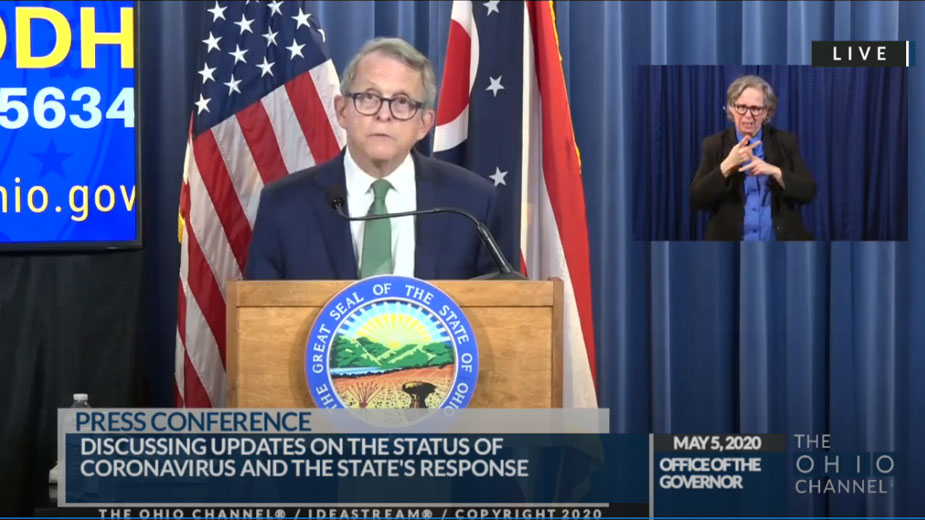DeWine Cuts $775M in Spending to Balance Budget
Updated 4:00, May 5 | DeWine comments on Rainy Day fund and funding for wraparound services at schools
YOUNGSTOWN, Ohio — Facing a fiscal-year budget shortfall in the month of April of $776.9 million, Gov. Mike DeWine is issuing spending cuts for the remainder of 2020.
In the last two months, budget projections for the fiscal year “have taken a rather dramatic turn,” falling from the state being more than $200 million ahead of its estimates at the end of February, DeWine said during Tuesday’s briefing. In an effort to balance the budget for the next two months, the state is reducing spending from the general revenue fund by $775 million for the remainder of 2020, with education and Medicaid taking the brunt of the cuts.
“We cannot continue onward as if this was a normal period of time,” DeWine said. “Unlike the federal government, we have to balance our budget. And we intend to do so.”
Ohio operates on a two-year budget cycle with the fiscal year running from July 1 to June 30, DeWine explained. Currently, the state is beginning the 11th month of the 24-month cycle, and the budget must be balanced in between each of the separate years.
Spending reductions for the reminder of 2020 include:
- $300 million in K-12 foundation payments
- $110 million from higher education
- $55 million in other educational budget line items
- $210 million in Medicaid spending
- $100 million for other agencies
DeWine has been in contact with the legislature about the cuts and looks to consult with leaders from both the House and the Senate.
Education expenses account for more than half of the proposed $775 million in cuts, equating to about a 3.7% reduction in education funding year-over-year. In an effort to establish predictability for schools for the next school year, DeWine opted to make the cuts now instead of when the next year has already begun, at which time they would be more dramatic, he said.
Public and private schools are still waiting to hear what the next school year will look like as the novel coronavirus remains a factor, whether schools will be able to reopen their brick-and-mortar locations or if they will have to continue with full remote learning.
“The cruel nature of an economic downturn is at the time you are in need fo a social safety net is also the time when government revenues shrink,” he said. “Any cut to education is difficult. But we have an obligation to do our best to balance these cuts and protect the most vulnerable of our students. And we intend to do that with these cuts.”
During questions from the media, DeWine indicated the cuts would likely not impact wraparound services, including after-school programs, tutoring and counseling. In July 2019, the governor signed a two-year state budget that included $675 million for wraparound services for at-risk, public-school students.
“I made a commitment that we would continue funding wraparound services, and we’re going to do everything that we can to continue that commitment,” he said. “Many of the schools have relied upon that, have entered into long-term contracts, or contracts that go beyond the next several months. So we’re going to continue the funding on wraparound services.”
Kim Murnieks, director of the Office of Budget and Management, will be available during Wednesday’s briefing to provide additional explanation on the budget cuts.
Of the money in the budget that is Ohio taxpayers’ money, 9.4% is spent on operating expenses of state agencies, while 86.2% is currently distributed across the state as subsidies to schools, higher education, Medicaid services and local government agencies. Another 4.5% makes up debt service expenses.
Each state agency, with the exception of the Department of Rehabilitation and Correction, will take cuts, including the governor’s office. Hiring freezes at state agencies that were ordered on March 23 will remain in effect. DeWine has asked agency directors to continue to identify savings for the remainder of this fiscal year as well as next fiscal year.
In addition, the governor said state agencies will operate under the travel freeze, with the exception of staff providing direct services with regard to the pandemic.
“Further, agencies will immediately freeze new requests for contract services, except for those services that are necessary for emergency response,” he said. “And will strictly scrutinize the continued need for those services.”
Agencies will also suspend purchasing authority for nonessential purchases, with continuation of only mission critical contractual services, he noted.
The budget shift is “the most dramatic swing I can ever recall,” commented Lt. Gov. Jon Husted. While nobody is certain how long the revenue issues will last, it’s prudent “to plan for the long haul,” he said.
That’s why it’s important to heed guidance from state and local health officials about living with coronavirus in an effort to protect lives and livelihoods, Husted said.
“We know that we have to get the economy moving so that people can pay their bills, and so that the private economy, which funds public services, can be as robust as possible,” he said.
For now, there is no plan to dip into the state’s “rainy day” fund, DeWine said. At least, not for the next two months. “Simply stated, we are going to need that money,” for the next year and possibly the year after, he said.
Copyright 2024 The Business Journal, Youngstown, Ohio.



